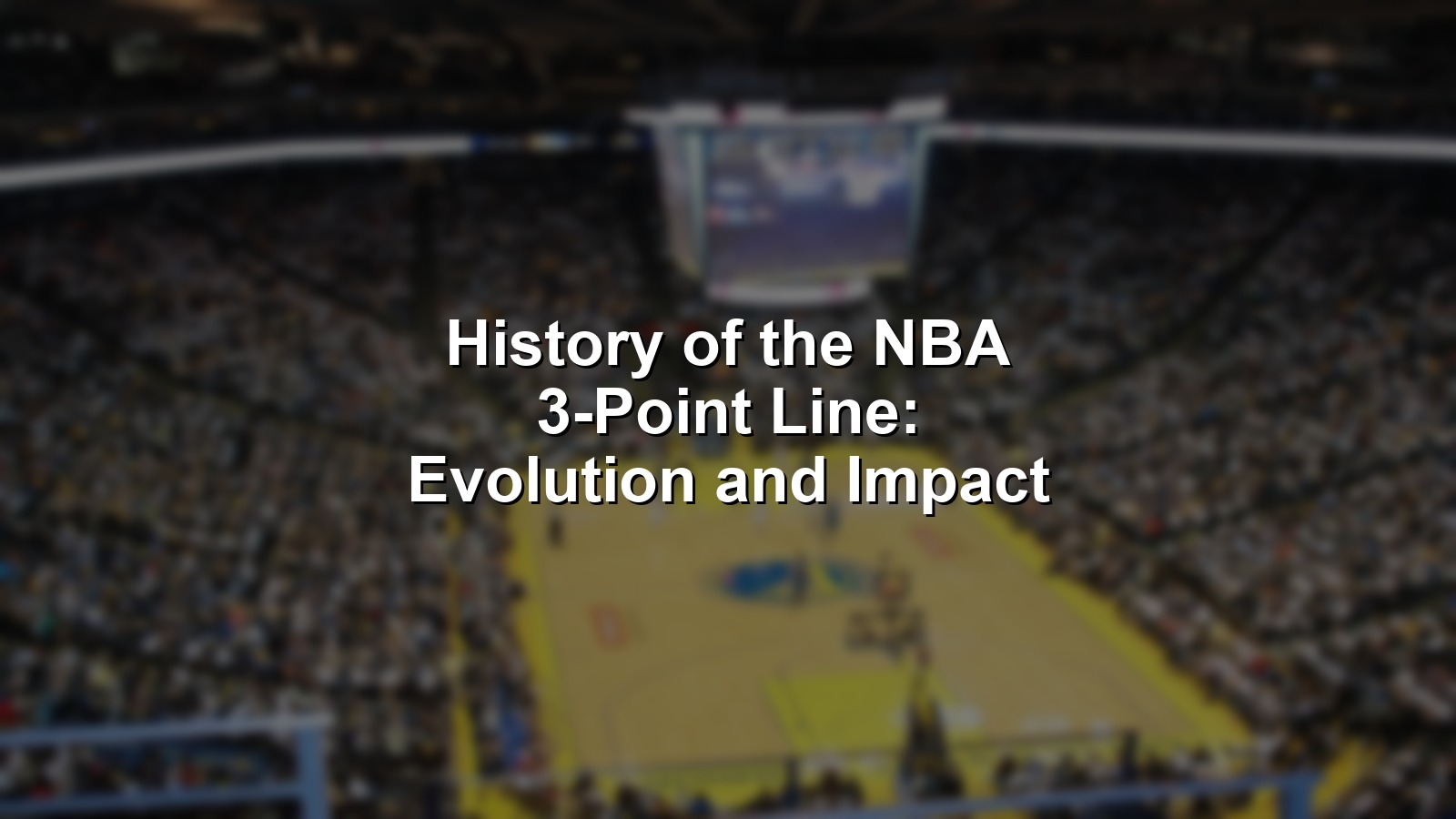
Walk into any gym today, and you’ll see pickup games built around the arc. The 3-pointer has become the sharpest weapon in basketball, reshaping rosters, analytics, and even playground dreams. But the history of NBA 3-point line is anything but straightforward—a story stitched with bold experiments, icons who bent the game, and unforgettable moments that changed how we see basketball.
Every 3-point bomb we celebrate today connects back to deep league debates, title runs, and the way fans see greatness. Decades ago, what seems common now was a radical act. Following the arc through NBA history means following shifts in power, culture, and how teams chase trophies.
Here, we break down the 10 turning points and moments that made the 3-point shot the center of the modern NBA, mixing heroics, controversy, and the steady march of innovation.
Context: Why This Matters
The argument never ends—what’s worth more: rings, talent, or changing the game itself? Some legends collect trophies with brute force, others with subtle skill, but only a few shift the NBA’s entire logic. That’s the tension behind every LeBron-vs-Jordan, Curry-vs-Harden, or Bird-vs-everyone argument.
The arc is where basketball’s competing values clash. Championships matter, but so do highlight moments and the ability to force the league to adapt. From old heads at the barbershop to beat writers on deadline, everyone debates if the 3-point revolution made ball better—or “ruined” something pure. Understanding the history of NBA 3-point line means wrestling with those trade-offs.
Methodology
Ranking the 10 most significant moments (and trends) in the history of the NBA 3-point line took more than just stat-checking. Here’s how we built this list:
- Game-changing moments—Signature shots and games that shifted the arc’s meaning.
- Long-term impact—How much did this alter how all teams and players approached the game?
- Championship relevance—Did it fuel title runs or remain a curiosity?
- Stats and innovation—Historical numbers from NBA official stats, Basketball-Reference, and Hall of Fame resumes.
- Media and fan consensus—Weighed debates from longstanding NBA media outlets, plus fan and player sentiment.
- Rough weighting: Impact/change (40%), longevity (30%), titles (20%), style/legacy (10%).
For more history and context, see primary resources at NBA.com History and the Basketball Hall of Fame.
The Moments That Changed Everything
1. The First NBA 3-Point Shot (Chris Ford, 1979)
It started quietly: October 12, 1979. Boston’s Chris Ford steps up and drains the NBA’s first-ever 3-pointer. The crowd barely reacts. Magic Johnson is making his own pro debut, and most players treat the new arc like a gimmick.
But as that shot drops, a fuse is lit. The league, coming out of the disco era, experiments with what feels like a carnival trick. Over time, though, the shot will become the signature image of innovation in basketball.
“It was just another shot—until suddenly, it wasn’t,” Ford later said.
Key facts
– Date: October 12, 1979
– First NBA regular-season 3-point make
– NBA adopted line from the ABA
Authoritative sources: NBA.com: The history of the 3-point shot, Basketball-Reference: 3-point records
🧵 On X
https://x.com/search?q=Chris%20Ford%20first%203-point&src=typed_query
2. Larry Bird’s 1986 Three-Point Shootout
Saturday night, 1986. Bird strolls into the locker room, asks who’s playing for second, and then buries the field with his last rack—a single, iconic finger held aloft before the ball even sinks.
This was more than All-Star theater. Bird represented a new era of wing players with both power and range, pushing the league to value shooters who could break zones and close games. The legend only hit 649 regular-season threes, but for a generation, he made the deep shot aspirational.
Bird’s cocky confidence made the 3-pointer cool. His battles with Magic, and his clutch shooting late in playoff games, forced defending champs to rethink lineups—even if the league itself was still slow to embrace the arc.
“I didn’t care where the line was. I’d shoot from the stands if I wanted,” Bird joked.
Key facts
– Three-time 3-Point Contest winner (1986-88)
– Two NBA MVPs after 3-point was introduced
– “Heat check” legacy
Authoritative sources: Basketball-Reference: Larry Bird stats
🧵 On X
https://x.com/search?q=Larry%20Bird%203-point%20contest&src=typed_query
3. The 1994–1997 Shortened 3-Point Line Era
February 1995, Game 1: The league’s best shooters step up. The NBA had shortened the arc from 23’9″ to a uniform 22′ to “open up the game” amid low scoring. Suddenly, everyone’s launching—from bigs to sixth men. Dennis Scott sets the (then) record with 267 threes in a season, and role players like Steve Kerr thrive.
But the shift backfired. Dull, crowded paint gave way to a shot-heavy game some called “unnatural.” Scoring (temporarily) jumped, then teams adjusted. In 1997, the NBA moved the arc back, but the message was clear: a generation was now raised on the 3-point idea.
“It was like an experiment gone wild,” joked Kerr.
Key facts
– 3-point line at 22 feet (1994–97)
– Major jump in leaguewide 3-point attempts
– Influenced player development
Authoritative sources: NBA.com: The evolution of the 3-point line
🧵 On X
https://x.com/search?q=NBA%201994%20shortened%203-point%20line&src=typed_query
4. Ray Allen’s Game 6 Miracle (2013 Finals)
Heat vs. Spurs, seconds ticking away. Miami’s title hopes are slipping when Ray Allen backpedals to the corner, catches, and releases—legs nearly tangled—tying the game and saving a dynasty. The Heat win in OT and take Game 7 days later.
Allen’s shot wasn’t just a title-saver; it was the blueprint. Every contender since has built rosters to find their Ray Allen moment—an elite specialist who stretches defenses, then breaks them with a single motion.
“I practice that shot every day. Never know when it matters most,” Allen said.
Key facts
– NBA all-time 3-point leader until 2021
– Key to Celtics (2008) and Heat (2013) titles
– Career: 2,973 threes made
Authoritative sources: Basketball-Reference: Ray Allen, NBA.com: Game 6, 2013 recap
🧵 On X
https://x.com/search?q=Ray%20Allen%202013%20Finals%203-pointer&src=typed_query
5. Stephen Curry’s MVP Seasons (2015–2016)
Spring 2016. Steph Curry pulls up from 37 feet in Oklahoma City—buzzer beater, game-winner. Announcers lose their minds. The world realizes: the 3-point line isn’t a limit; it’s just the beginning.
Curry’s 402 threes set a record that seemed ridiculous. But it was more than numbers. He forced every defense to stretch, reinvented NBA spacing, and opened the floodgates for “pace and space” rosters. As multiple MVP and a leader of a dynasty, he’s the face of the 3-point era.
Even skeptical old heads admitted: “You can’t coach what Steph does. He changed everything.”
Key facts
– Two MVPs (2015, 2016), one unanimous
– 402 threes in 2015–16 (record at the time)
– Four titles (2015, 2017, 2018, 2022)
Authoritative sources: Basketball-Reference: Stephen Curry, NBA.com: The Steph effect
🧵 On X
https://x.com/search?q=Stephen%20Curry%20long%203-pointer&src=typed_query
6. The 2014 San Antonio Spurs’ Beautiful Game
Game 3, 2014 NBA Finals. Ball whips around the perimeter—Kawhi to Parker to Green to Diaw. Open 3-pointer, swish. The Heat look helpless.
The 2014 Spurs didn’t have one Curry-level shooter, but they weaponized the arc with pace, unselfishness, and European-influenced flow. On their way to a fifth title, they made kick-out threes an essential salt to NBA offense.
Coaches everywhere borrowed the recipe—inside-out, relentless motion, and shooters in every corner.
“The ball found energy. The threes were rhythm,” Manu Ginóbili explained.
Key facts
– 2014 NBA Champions
– Top five in 3-point % that year
– Pioneered “.5 decision” system
Authoritative sources: NBA.com: 2014 Finals recap, Basketball-Reference: 2014 Spurs
🧵 On X
https://x.com/search?q=2014%20Spurs%20ball%20movement&src=typed_query
7. “Seven Seconds or Less” Suns (2004–2007)
It’s 2005, and Steve Nash is running the break. Instead of the standard layup, he flips the ball to Joe Johnson, wide open on the wing—pull-up three, splash.
Mike D’Antoni’s Suns were mocked early for “not playing winning basketball.” But their running, gunning 3-point barrage upended conventional wisdom. Nash’s vision, Amar’e Stoudemire’s rim pressure, and the team’s abandon inspired a new offensive normal.
The Suns never reached the Finals, but they warped the league. Today, every team chases their blend of speed, spacing, and shooting.
“We just played with joy. The threes let us play free,” Nash recalled.
Key facts
– 2005, 2006: Top in league 3PA, 110+ points/game
– Steve Nash: two MVPs
– Reached Western Finals twice
Authoritative sources: Basketball-Reference: 2005 Suns, NBA.com Retrospective
🧵 On X
https://x.com/search?q=7%20seconds%20or%20less%20Suns%203-point&src=typed_query
8. Klay Thompson’s 37-Point Quarter (2015)
It’s January 23, 2015. Klay Thompson goes supernova—13-for-13 in the 3rd quarter, draining nine threes for a record 37 points in 12 minutes. Teammates and even the opposing Kings are laughing in disbelief.
Thompson’s display was more than a viral highlight. It was proof that, in the 3-point era, momentum could belong to anyone—one hot shooter could erase a deficit instantly. Klay’s game inspired every “heat check” hero from high school to the pros.
Steve Kerr said, “Nobody’s ever seen anything like that. Not even Steph.”
Key facts
– NBA record: 37 points in one quarter
– 14 threes in a single game (2018, also a record)
– Integral to Warriors dynasty
Authoritative sources: ESPN recap, Basketball-Reference: Klay Thompson
🧵 On X
https://x.com/search?q=Klay%20Thompson%2037%20point%20quarter&src=typed_query
9. James Harden’s Stepback 3
It’s 2019. Harden brings the ball up in Houston—defender in his grill, shot clock draining. In one motion: double step-back, high arcing three, net. Commentators argue if it’s legal. Fans argue if it’s beautiful.
Harden made the stepback 3-pointer a modern weapon, combining efficiency and un-guardability. In 2019, he averaged 13.2 attempts per game—numbers unthinkable a decade earlier.
He didn’t win a ring, but Harden’s influence on volume, shot creation, and isolation play tilts every NBA defense today.
“Harden forces defenses out of shape in ways we’ve never seen,” said a rival coach.
Key facts
– 2018 MVP
– Averaged 36.1 PPG (2018–19)
– 3-pointers as central to scoring title campaigns
Authoritative sources: Basketball-Reference: James Harden, NBA.com: Harden’s historic 2019
🧵 On X
https://x.com/search?q=James%20Harden%20stepback%203&src=typed_query
10. Analytics and the “Moreyball” Era
The early 2010s. Houston, led by GM Daryl Morey, systematically moves as many shots as possible beyond the arc or to the rim. Employee laptops stacked next to the Gatorade buckets. What started as “geekball” becomes gospel.
By 2018, the Rockets attempt more than 42 threes per game—double what Curry’s Warriors shot just years earlier. Basketball statisticians use data to bend the arc further and reshape pace, shot selection, and even player salaries.
Detractors complain, “It’s all math—where’s the fun?” But the 3-point revolution is mathematically sound, and now, global.
“We just wanted to win by the numbers. And it’s working,” said Morey.
Key facts
– Houston set team 3PA/3PM records
– Inspired leaguewide analytics movement
– Teams now avg. 35+ 3PA/game
Authoritative sources: NBA.com: Analytics revolution, Basketball-Reference: Rockets team stats
🧵 On X
https://x.com/search?q=Moreyball%20Rockets%203-point%20revolution&src=typed_query
What Comes Next
This list isn’t just a walk through nostalgia. The history of NBA 3-point line is a living argument—each season, a new star pulls defenses even further from the rim. What started as a weird experiment has become the very definition of “modern” basketball.
The debates won’t stop. Will Victor Wembanyama stretch the arc at 7’4”? Can specialists thrive, or will every future All-Star need Curry range? Even as teams break new 3-point records each year, some coaches whisper about the next zig in the endless NBA chess match.
Every iconic arc moment, from Larry Bird’s trash talk to Curry’s logo bombs, is now part of how we measure greatness. The next generation is watching—and will add their twist, shot by shot.



